CCF: Ex Recruits Dawn and Ex Bayonet Point
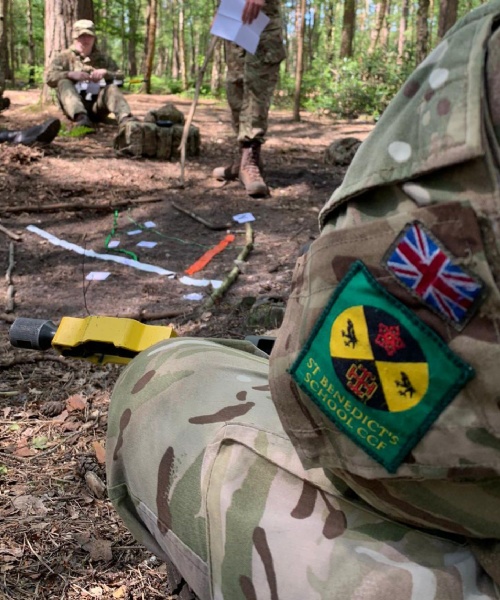
St Benedict’s Combined Cadet Force has had an excellent start to the year, with a high number of new recruits and two successful training exercises.
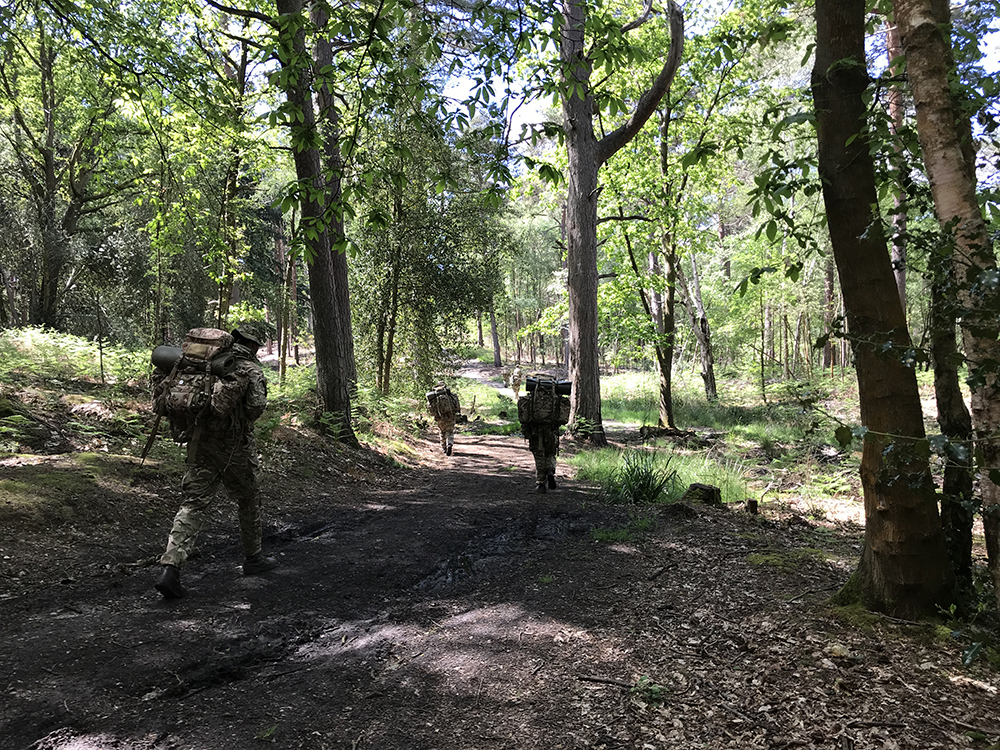
In early October, 75 new cadets in Year 9 from St Benedict’s and Cardinal Wiseman (our partner school), took part in Exercise Recruits Dawn: spending a day and night at Longmoor Military Training Camp, Hampshire, the recruits learned the basics of drill, skill-at-arms, military knowledge, and familiarised themselves with the obstacle course. 10 Sixth Form NCOs also attended, and developed their leadership and instructional skills.
I speak for all of the recruits when I say how much I thoroughly enjoyed our trip. We are so excited for our next one!
Freddie (Year 9)
Over the same weekend, 55 cadets in Year 10 and 12 Sixth Form NCOs took part in Exercise Bayonet Point III, also at Longmoor. Cadets had the opportunity to develop their fieldcraft and patrolling skills, laying the foundations for Section and Troop level leadership.
Lots of dedicated NCOs were out for all three days, on both exercises!
Exercises in the field are a great opportunity for cadets to practise all the fieldcraft they have learnt so far and of course gain experience in some new ones. Overall, I think both the cadets and the NCOs did very well and everyone seemed to enjoy it too."
Natalia (Year 12)
The aim of the CCF is to develop transferable skills and qualities which will be useful in later life. These include leadership, responsibility, self-confidence, initiative, perseverance and teamwork. All activities promote the core values of the CCF, which are: courage, discipline, respect for others, integrity, loyalty and selfless commitment.
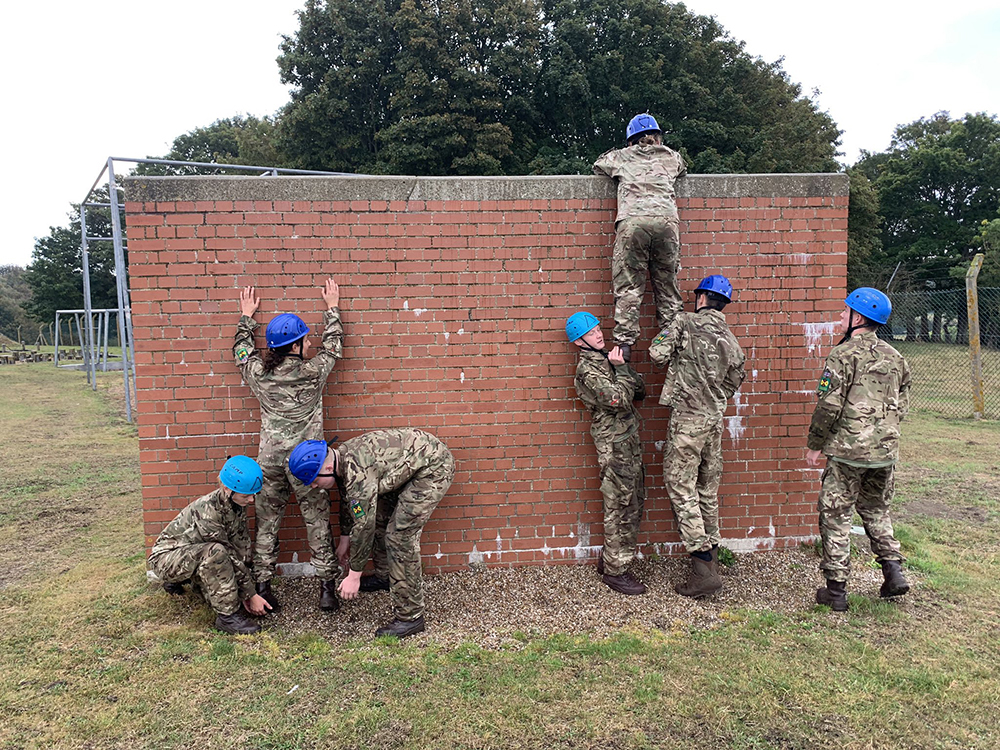
Ex Recruits Dawn
Katia :
After getting back from my trip with the CCF, I realised how much team building, life skills and good experience it is. My favourite part of it was the rifle training because it was fun learning how to actually shoot and obstacle course as it required a good amount of physical skill but you couldn’t do it on your own. Other activities I enjoyed were camouflage and concealment, which linked to why things are seen, navigation skills, survival skills and drill.
Freddie :
On Sunday 10th October at 0730 hours, the troop of new recruits from St Benedict’s and Cardinal Wiseman set off, bleary eyed, to Longmoor Camp. On arrival we were escorted to our dormitories. The rooms were laid out in generic military fashion; a bed and locker awarded to each person. After enjoying a delicious lunch (thankfully not the minimal rations we were expecting!) our sections were marched to a woodland clearing where we undertook various activities including an obstacle course which involved climbing over 10ft high walls and crawling under metal bars.
We learned many things during the course of our first day at camp including how things can be seen using the “Seven S’” and how to apply cam-cream to blend into our surroundings. After a roast dinner we were then taught how to perform normal safety precautions (NSPs) on a rifle. The rifle used was the L98 A2 Cadet GP Rifle.
Day two started early at 0530 hours! We were woken and told to put our uniform on ready for uniform and cleanliness checks. It was then a quick breakfast before activities and lessons started; hand signals and how to attach a sling to our rifles. We also did a lot of drills!
We departed camp mid-afternoon after an exciting two days away under Mr Hullis and Mr Sadiq’s watch. I speak for all of the recruits when I say how much I thoroughly enjoyed our trip. We are so excited for our next one!
Amelia:
The day started very early with the recruits meeting at 7.30am to check our kit. We departed for the long journey to Longmoor Camp arriving by mid-morning. Most recruits were intrigued about the day ahead. Upon arriving at camp, we proceeded to our rooms before having lunch followed by carrying out six varied activities throughout the afternoon starting with how to set up a shelter. We also did drills, admin in the fields, obstacle course and “why things are seen”, camouflage and concealment. The most enjoyable for me was the obstacle course and camouflage and concealment.
After dinner the day finished with drills at 9-10pm, followed by rifle NSP practice. The day came to an end at 11.30pm with most recruits exhausted from the activities.
The following morning the wake-up call was at 530am with most people already up and excited about the day ahead. Following a cooked breakfast, we proceeded with 5 activities in the morning with the most enjoyable being the rifle NSP for most. Orienteering and hand signals were also a part of the morning activities plus drills. We were back on the coach after lunch and finished the day off with a parade at school.
Oliver:
Everything was good and very fun. The best activities were the skill at arms and the obstacle course for obvious reasons. I also enjoyed the lessons inside classrooms like the military knowledge, hand signals and navigation. The drill was very interesting to learn all the movements for a parade. We had an early start in the morning at 5.30am which was early but not too early and the sleeping bags and beds were perfectly easy to sleep in. Unexpectedly, the food was actually very nice and I was able to enjoy it with a perfect amount of time to spare. Overall, I would definitely recommend this trip to people who are unsure if they want to do CCF because it will give them an insight into what things will be like in the future.
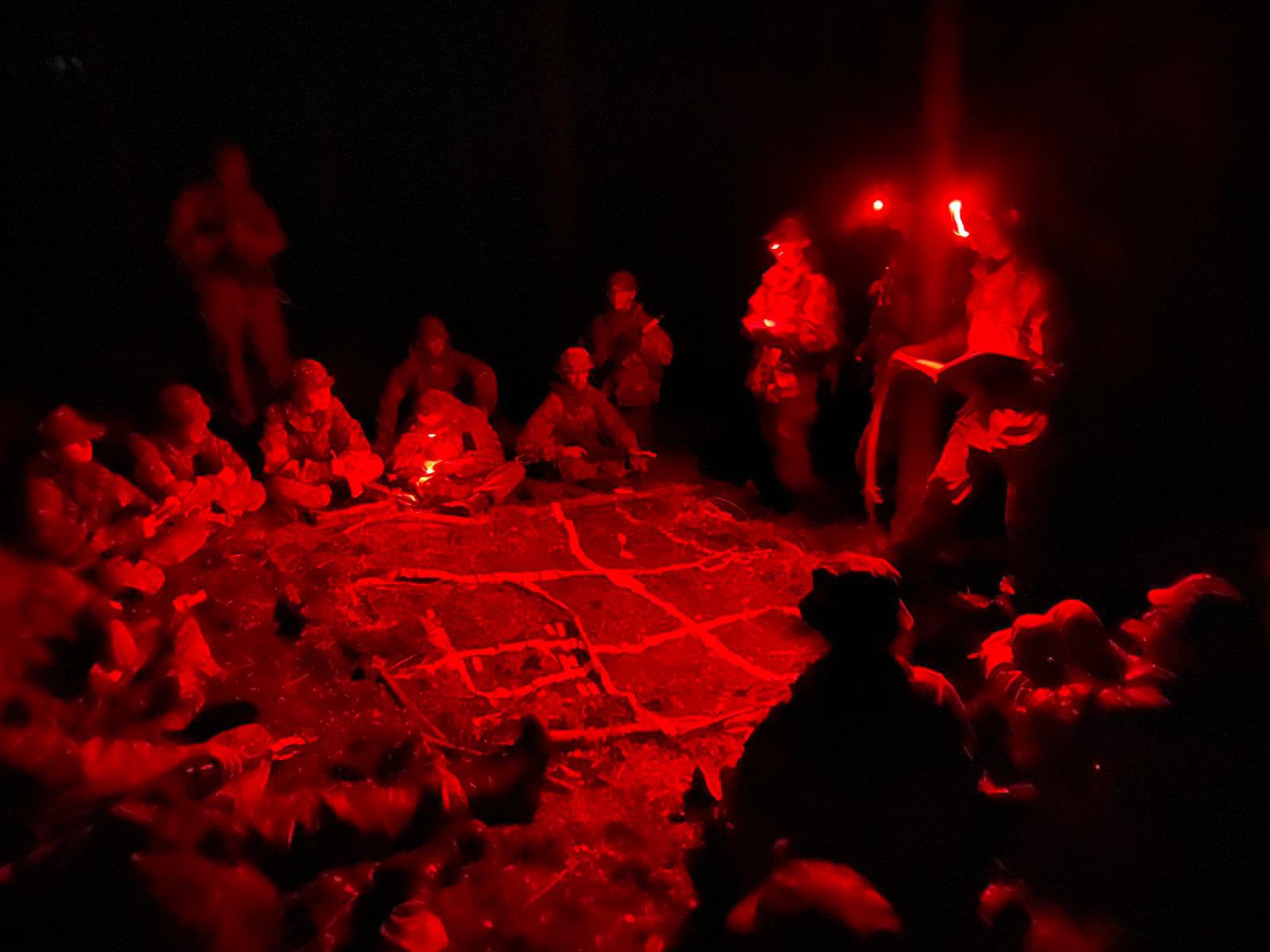
Ex Bayonet Point
Callum:
During Ex Bayonet Point I had a great time, there were many hard moments for example having to wake up in the middle of the night to do sentry duty and patrolling in darkness, but I managed to push myself through them knowing fun activities were to come. By far the fun and adrenaline pumping moments outweigh these tough moments. I enjoyed the platoon ambush at night because watching the muzzle flashes go off in pitch darkness felt awesome. Overall Ex Bayonet Point was one of the best experiences I have ever had with the CCF.
Alessandro:
Bayonet Point III. We left very early on Saturday morning, checked our bags and travelled for an hour to Longmoor. This is a military base in Hampshire. As soon as we arrived, we were given our rifles and accessories after which we went straight into the forest and walked 1.5km with our heavy bergens on our backs. We made platoon harbour which served as our base over the next two days. Once settled, we made a sentry plan and started the rota. I was on sentry for 5 times in total, including throughout the night. We had to work closely together, especially at night and during the ambush in the middle of the dark wood. Firing the rifle in the night was exciting because you could see the flash at the muzzle clearly. When we got back to the main base on Sunday afternoon, we cleaned our rifles and returned them. I most enjoyed the ambush, really quite thrilling to do this in the middle of the night when visibility is low and you need to rely on other senses too.
Natalia (Year 12 - NCO):
Having spent two days in the field, the second-year cadets came home from Ex Bayonet Point having learnt and developed their skills immensely. Arriving bright and early at St Benedict’s School on Saturday, the weekend started with a complete check of the packing list – you don’t want to be setting up you basha and realise you left your tent pegs at home. Once we arrived at Longmoor Training area, the Exercise could begin.
After making sure the cadets were properly camouflaged (with the help of cam-cream and ferns), their weapons were oiled and they’d finished a ‘delicious’ lunch of rations, we started patrolling towards our platoon harbour area. This gave us a good opportunity to use those fieldcraft skills that we had learnt in the classroom and put them into practice. For example, the cadets got to use hand signals to communicate on the patrol. They also did a snap ambush, lying in wait on their bergens, making sure the enemy wasn’t following. Setting up the platoon harbour is a very important task, requiring the contribution of everyone in the platoon. There’s quite a bit to do but by the end the cadets would have a secure and protected harbour in which they’d be able to get (at least some) sleep.
After dark, the cadets set out to execute a Platoon ambush on the enemy. This part is always exciting and the cadets get the chance to do some blank firing. At night, visibility is more limited and it can be harder to find your destination. However, our platoon managed to reach the ambush site without incident and laid in wait for the unsuspecting enemy. Doing fieldcraft activities such as ambushes are a favourite amongst the cadets. It’s one of the things that makes the CCF so different from any other co-curricular options. You get learn and develop skills which you never thought you would – skills that end up useful in many ways in later life. You might never need to do an ambush once you leave school, but you will need the perseverance, diligence and the discipline. After successfully ‘destroying’ the enemy, we returned to the platoon harbour for a well-deserved few hours of sleep.
First thing in the morning the cadets were surprised with enemy fire – that certainly woke everyone up. Quickly packing up their kit into their bergens the cadets rushed out of the platoon harbour before any more enemy could arrive. Once the cadets had left the area, the exercise ended and the NCOs made sure their sections were complete and safe.
Exercises in the field are a great opportunity for cadets to practise all the fieldcraft they have learnt so far and of course gain experience in some new ones. Overall, I think both the cadets and the NCOs did very well on this Exercise and everyone seemed to enjoy it too – they definitely deserved that nap on the coach home!
Finally, I’d like to the thank all the staff, especially Mr Sadiq and MrHullis, for providing us with this amazing opportunity which we all value and enjoy.
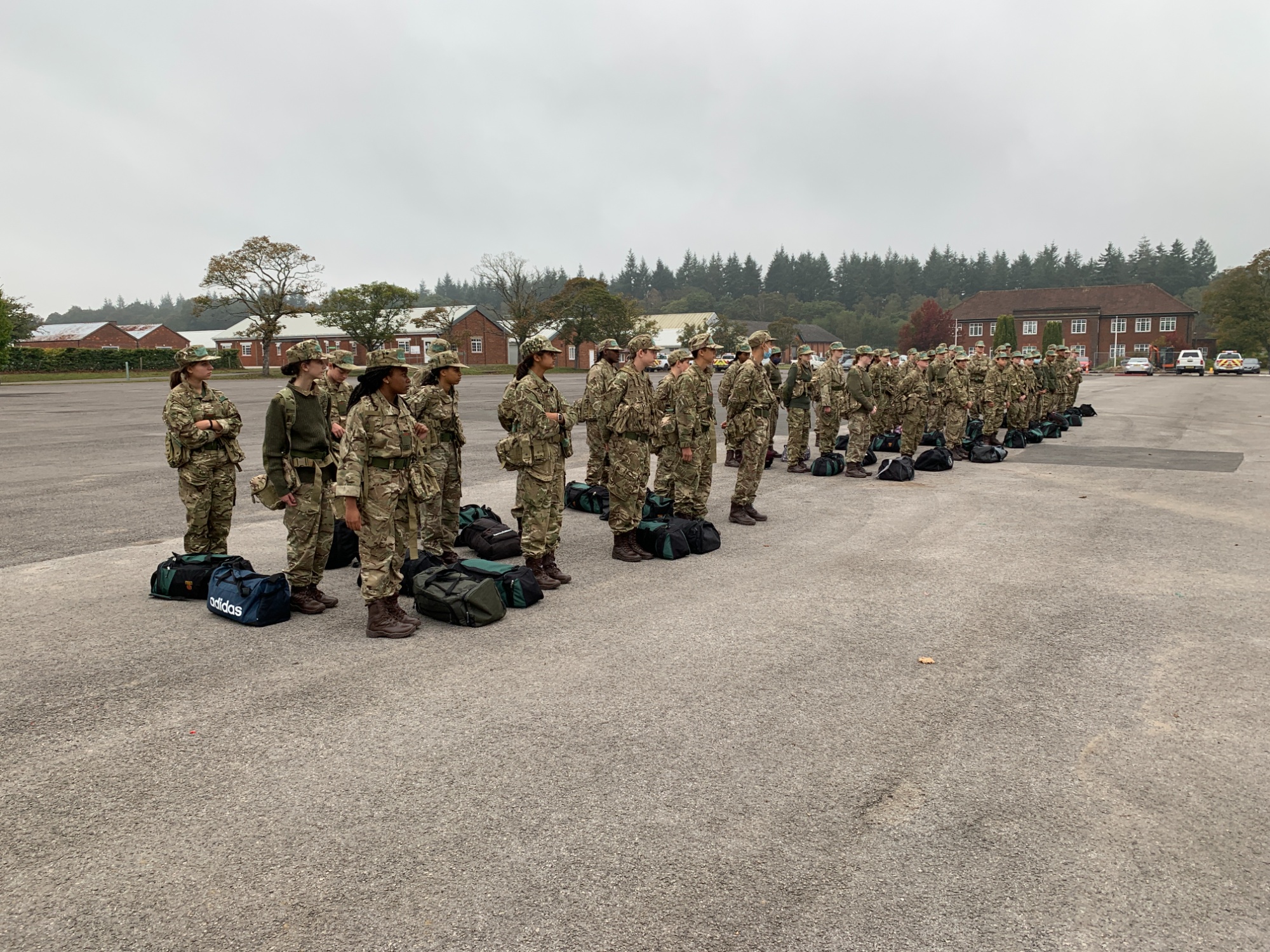
Sophia (Year 12 - NCO):
Last Saturday, Wilding Troop departed for Longmoor Camp, over 4000 acres of beautiful woodland, to have their second tactical overnight exercise. During this weekend, these cadets gained experience in efficiently operating in a section under time pressure, and their leaders (non-commissioned officers) practised working at a platoon level.
The morning started with preparing for battle: the cadets applied personal camo to their faces, and foliage to their uniforms; oiled their weapons; and loaded their magazines with blank ammunition. Next, each platoon patrolled to their platoon harbour (the site where we set up camp). Before occupying the platoon harbour we performed a snap ambush - we lay in the tree line along the road to ensure no enemy was following us. The cadets were so quiet and stealthy that none of the dog walkers or cyclists even noticed they were there!
Once at their respective platoon harbours, the cadets that were nominated second in command for each section, started the sentry rota going. This meant there were people on watch at all times - every hour of the night. At 2030 hours the platoon commander gave us our orders in the cover of darkness, with the model of the area created by the platoon sergeant: we were about to set off on a platoon ambush! Patrolling through thickly vegetated wooded areas with only a slither of the moon in the sky, proved to be quite challenging. Through the excellent leadership of our platoon sergeant and the effective patrolling drills all the cadets had learnt, we avoided getting lost or split up.
The platoon ambush was a huge success. We completely smashed the enemy: the thunder of almost 100 rounds echoed through the trees. Immediately, my fire team conducted searches on the enemy casualties, which I found particularly enjoyable. We sprinted out to take their rifles and at once began to check for casualties and how much ammunition we had left, before tactically returning to our platoon harbour - buoyant with our victory.
Although cold, the exhausted slumber of the cadets was only interrupted by sentry duty. By 0600 hours the following morning, the cadets were up and then promptly in all-round defence under the leadership of their section commanders. Out of nowhere, we were attacked! The enemy was again defeated as the section commanders ordered their cadets to fire. However, we had to quickly leave our platoon harbour to prevent being contacted again.
It was finally the end of the exercise. We were ready to get back on the coach and get stuck into cleaning our rifles. As a section commander, I now feel way more confident leading people in the field; and the improvement of Wilding Troop over the course of the weekend was incredible.
Jamieson:
It was 7:00 in the morning when we arrived at school, and we were all looking forward to Ex Bayonet Point. We set off to Longmoor at around 9; after checking we had everything, we all piled onto the coach and sat through the hour or so it took to get there.
We arrived at around 10:00, and after collecting our rifles, magazines, ear defenders and weapon cleaning kit we walked towards our first location. We arrived, and were briefed with what we were going to do. We were told that we would be setting up a platoon harbour (a triangle shaped, patrolled “base of operations”). Once we had been fully briefed, we put on our Bergens and webbing, and began the walk to our platoon harbour. We walked for about 5 minutes, then sat down to cook our food. It came in the form of ration packs which we had to place in boiling water to cook. We took it in turns to be on sentry and watch out for any enemies that could be nearby. After we had all eaten, we gathered our things and set off again. This time we walked for about 1km, when we decided to go into the snap ambush position. We lay down on the side of the path we were walking down, and aimed our rifles. We waited for about an hour in this spot until we were all comfortable that we weren’t being followed. We then continued and made it to the spot where we would be setting up our platoon harbour. In our 3 sections, each one went to a different side of the platoon harbour, we set up our bashas and cooked our next meal. The time was around 16:00. We were given our timings for what time we would be on sentry: my times were 19:00 till 20:00 and 2:00 till 3:00. We were given a bit of time to ourselves, then we were briefed about what we would be doing. It was about 19:30, and we were instructed that we would be conducting an ambush on our enemy. We were then told where we would be conducting the ambush from, and who would go and search for information, if it was a success. We were then allowed to sleep until 22:30, when we were awoken and got ready to move. We packed up our bashas and sleeping bags, and put on our rifles. We then prepared to move. It was pitch black, you could hardly see a thing in front of you. We communicated via hand signals so as not to alert the enemy of our position, but this was very hard to do, considering the light levels and distance between each of us. We walked for about half a kilometre, scaling rocks and fallen logs, and avoiding branches and bushes. We made it to our first location then lay down and waited for the runners to go and check on the path ahead. After an hour of laying in the wet grass, clutching our rifles and not being able to see anything, we were instructed to move again. We stood up, got into our order, and continued to navigate our way through the night. After another half a kilometre of walking down hills and narrowly avoiding rocks, we finally made it to where we would conduct the ambush. I lay next to a tree, my cheek resting on my rifle, and my ear defenders on. Our magazines were loaded, and the silence was deafening. My finger was clutching the trigger. We were told to open fire, once we heard the first bullet being fired. Suddenly it happened, we all began to fire upon the enemy. Once we were told to stop firing we discovered that an enemy had survived the ambush, and was nowhere to be found. We lay still for another half an hour, until we were told to stand up. We then walked back to our platoon harbour, and after a quick debriefing, were allowed to go back to sleep. However, I was on sentry so I would have to wait. I was on sentry with Troy, my fellow recruit, for what felt like an eternity, fighting off the harsh temperatures and the urge to fall asleep. Once I was freed from my post I stumbled around for about half an hour, until I found my basha, which my partner had set up, and who was already fast asleep. I unpacked my sleeping bag and roll mat, climbed in with my boots on, placed my rifle next to me and fell asleep. I awoke three times in the night due to the fact it was freezing. But apart from that I got a solid four hours of sleep. We were awoken at 06:00, and were instructed to pack everything away, grab our rifles, and get into the prone position ready to fire. Suddenly we heard gun fire, the enemy were attacking! We began to fire back, and it only took 2 minutes for them to be defeated. We then gathered our things and set off once again. After walking for about 2 km, we finally made it back to the main area, and we all sat down. We then began to strip and clean our rifles, cook breakfast and change our socks etc. We stayed here for about 5 hours or so. As it began to rain, we packed everything up, put our rifles back together and went back to the armoury. We handed everything back, and emptied any of our remaining rounds into the relevant containers. We then sat down for about a bit, until finally at 14:00, we got onto the coach and endured the one hour back to school. Most of us fell asleep, and didn’t wake up until we arrived. We then climbed off of the coach, and finished cleaning the weapons for an hour once we got back to school. When we had finished we were allowed to leave.
We were all exhausted, and at that moment the only thing I wanted was a warm shower. And sleep. This trip was definitely one I won’t ever forget, and although it was hard, It was still a fun experience that definitely challenged us.
Did you know…?
- St Benedict’s School CCF was founded in 1930 and has been in continuous existence since
- Each year group is named after old boys of St Benedict's and Cardinal Wiseman
- The CCF wear the cap badge of the Corps of Royal Engineers (our affiliated unit is 135 Geographical Squadron, 42 Regiment RE, based in Ewell).
- Teeling (Recruit) Troop is named after Luke and Ambrose Teeling, killed in September 1914 and November 1918 - St Benedict's first and last casualties in the Great War)
- Wilding Troop is named after Pat Wilding, Head Boy of St Benedict's in 1942, killed in action in Italy in 1944)
- Casey Troop is named after Chris Casey, a former pupil of Cardinal Wiseman School, killed in Iraq whilst serving with 1st Battalion, Irish Guards, in April 2007
- Ward (HQ) Troop is named after Old Priorian Lt-Col Stephen Ward OBE, MC (Royal Engineers) died in Burma in May 1945
- The CCF exists in some 365 independent and maintained schools throughout the country